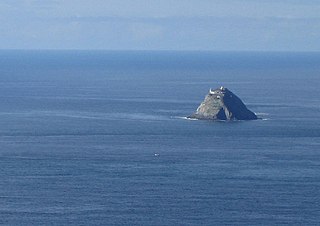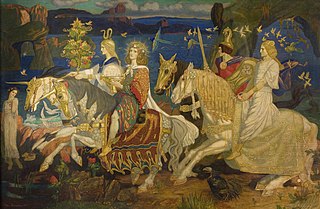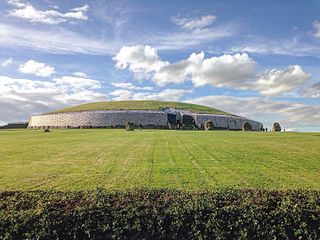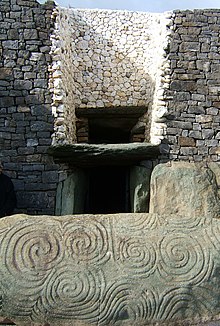
In Irish mythology, Donn is an ancestor of the Gaels and is believed to have been a god of the dead. Donn is said to dwell in Tech Duinn, where the souls of the dead gather. He may have originally been an aspect of the Dagda. Folklore about Donn survived into the modern era in parts of Ireland, in which he is said to be a phantom horseman riding a white horse.

Irish mythology is the body of myths indigenous to the island of Ireland. It was originally passed down orally in the prehistoric era. In the early medieval era, myths were written down by Christian scribes, who Christianized them to some extent. Irish mythology is the best-preserved branch of Celtic mythology.

The TuathaDé Danann, also known by the earlier name Tuath Dé, are a supernatural race in Irish mythology. Many of them are thought to represent deities of pre-Christian Gaelic Ireland.
The Dagda is considered the great god of Irish mythology. He is the chief god of the Tuatha Dé Danann, with the Dagda portrayed as a father-figure, king, and druid. He is associated with fertility, agriculture, manliness and strength, as well as magic, druidry and wisdom. He can control life and death, the weather and crops, as well as time and the seasons.

Boann or Boand is the Irish goddess of the River Boyne (Bóinn), an important river in Ireland's historical province of Meath. According to the Lebor Gabála Érenn and Táin Bó Fraích she was the sister of Befind and daughter of Delbáeth, son of Elada, of the Tuatha Dé Danann. Her husband is variously Nechtan or Elcmar. With her lover the Dagda, she is the mother of Aengus.
In Irish mythology, Elcmar or Ecmar is the husband of Boann and belongs to the divine Tuatha Dé Danann. It has been suggested that he is Nuada under another name, and he is sometimes confused with Nechtan, Boann's usual husband. At first glance he appears to be associated with horses but there is also a school of thought that says his name means The Evil One. In the Dindsenchas, he is called "lord of horses" and is described as a judge. Elcmar is described as having a fork of white hazel, a gold brooch, and a cloak.
In Irish mythology, Bodb Derg or Bodhbh Dearg was a son of Eochaid Garb or the Dagda, and the Dagda's successor as King of the Tuatha Dé Danann.

Étaín or Édaín is a figure of Irish mythology, best known as the heroine of Tochmarc Étaíne, one of the oldest and richest stories of the Mythological Cycle. She also figures in the Middle Irish Togail Bruidne Dá Derga. T. F. O'Rahilly identified her as a sun goddess.

Newgrange is a prehistoric monument in County Meath in Ireland, located on a rise overlooking the River Boyne, eight kilometres west of the town of Drogheda. It is an exceptionally grand passage tomb built during the Neolithic Period, around 3200 BC, making it older than Stonehenge and the Egyptian pyramids. Newgrange is the main monument in the Brú na Bóinne complex, a World Heritage Site that also includes the passage tombs of Knowth and Dowth, as well as other henges, burial mounds and standing stones.
In the Mythological Cycle of early Irish literature, Midir, Midhir or Mider was a son of the Dagda of the Tuatha Dé Danann. After the Tuatha Dé were defeated by the Milesians, he lived in the sidh of Brí Léith. The name Midir may come from the old Irish word for a judge, midithir.
Fúamnach, or Fuamnach, is Midir's first wife and a witch of the Tuatha Dé Danann in the medieval Irish text Tochmarc Étaíne. The text describes her as being intelligent (gáeth), cunning (trebar) and "versed in the knowledge and power of the Túatha Dé Danand", explaining that her fosterfather had been the wizard druid Bresal Etarlám. She is said to be of the progeny (clann) of Béothach son of Iardanél, who is probably identical with Béothach son of Iarbonel, the father of the Túatha Dé Danann in the Lebor Gabála Érenn.

In Irish mythology, Ethniu in modern spelling, is the daughter of the Fomorian leader Balor, and the mother of Lugh. She is also referred to as Ethliu.

Tochmarc Étaíne, meaning "The Wooing of Étaín/Éadaoin", is an early text of the Irish Mythological Cycle, and also features characters from the Ulster Cycle and the Cycles of the Kings. It is partially preserved in the manuscript known as the Lebor na hUidre, and completely preserved in the Yellow Book of Lecan, written in language believed to date to the 8th or 9th century. It tells of the lives and loves of Étaín, a beautiful mortal woman of the Ulaid, and her involvement with Aengus and Midir of the Tuatha Dé Danann. It is frequently cited as a possible source text for the Middle English Sir Orfeo. Harvard professor Jeffrey Gantz describes the text as displaying the "poetic sense of law" in Irish legal society.

The Mythological Cycle is a conventional grouping within Irish mythology. It consists of tales and poems about the god-like Tuatha Dé Danann, who are based on Ireland's pagan deities, and other mythical races such as the Fomorians and the Fir Bolg. It is one of the four main story 'cycles' of early Irish myth and legend, along with the Ulster Cycle, the Fianna Cycle and the Cycles of the Kings. The name "Mythological Cycle" seems to have gained currency with Arbois de Jubainville c. 1881–1883. James MacKillop says the term is now "somewhat awkward", and John T. Koch notes it is "potentially misleading, in that the narratives in question represent only a small part of extant Irish mythology". He prefers T Ó Cathasaigh's name, Cycle of the Gods. Important works in the cycle are the Lebor Gabála Érenn, the Cath Maige Tuired, the Aided Chlainne Lir and Tochmarc Étaíne.
In Irish mythology, Cermait, also anglicized as or Kermit, of the Tuatha Dé Danann was a son of the Dagda and brother of Aed and Aengus. He was killed by Lugh after he had an affair with Lugh's wife Buach. The Dagda cried tears of blood for his son, and later, while traveling with his son's body in the east revived Cermait with a healing staff. Cermait's three sons, Mac Cuill, Mac Cecht and Mac Gréine, avenged his death, and went on to become joint High Kings of Ireland. Another figure mentioned in the Dindsenchas, Conan Honey-mouth, is described as the son of the Dagda and may be the same figure as Cermait. Conan was killed with a spear by a son of Conall Cernach named Ferdoman.
Béḃinn or Bé Binn, in modern orthography Béibhinn, is an early Irish personal and mythological name. In some sources Béḃinn is a goddess associated with birth and the sister of the river-goddess, Boann. Béḃinn is also described as being an underworld goddess in both Irish and Welsh mythology, inhabiting either the Irish underworld Mag Mell or the Welsh Annwn, although it is unknown which is the original source.
Aed, or Aodh, is the prince of the Daoine Sidhe and a god of the underworld in Irish mythology. He is known from inscriptions as the eldest son of Lir, High King of the Tuatha de Dannan, and Aoibh, a daughter of Bodb Dearg. Aed is elsewhere described in the Dindsenchas as being the Dagda's son and brother of Cermait and Aengus killed by Corchenn of Cruach for seducing Corchenn's wife.

The Pursuit of Diarmuid and Gráinne is an Irish prose narrative surviving in many variants. A tale from the Fianna Cycle of Irish mythology, it concerns a love triangle between the great warrior Fionn mac Cumhaill, the beautiful princess Gráinne, and her paramour Diarmuid Ua Duibhne. Surviving texts are all in Modern Irish and the earliest dates to the 16th century, but some elements of the material date as far back as the 10th century.









